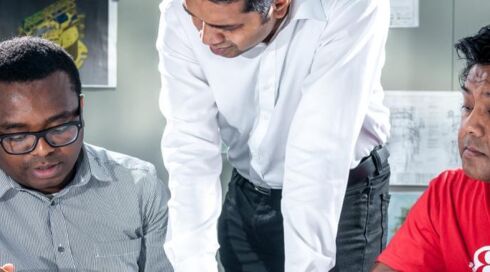3
Some of the most interesting stories that come from our professionals happen before their offshore careers begin. Vinay Sawant’s journey into mechanical engineering is just one of those stories.
Journey into Space
“I have always been looking for challenges and interesting projects that I could work on. When I was studying for my Masters in Aerospace Engineering, I was introduced to the Indian Space Research Organisation. My first project was to work on a light combat aircraft and to analyse the dynamics of the aircraft structure. Then after this I worked as the project manager for the structural analysis of another craft and this became the METSAT (Kalpana-1) satellite.” The METSAT is a meteorological satellite that collects data of the Earth’s atmospheric temperature. “Actually the METSAT was the most difficult design that I have worked on in my career however, my experience in the space industry helped me to progress into the offshore industry.”
From Orbit to Ocean
One of the key factors of Vinay’s role is in the detailed analysis that needs to be calculated for each structure. “When I had finished my PhD, the offshore industry wanted an expert in Finite Element Analysis. My first project was to design a heavy lifting equipment A-Frame which would be used for anchor handling vessels. I found that the challenge was not necessarily in the design of the structure but getting the approval for that structure.”
Providing the analysis for each structure is a vital part of being a mechanical engineer. By breaking down the engineering design this reveals the state of each component and allows the engineer to assess these in isolation. Vinay explains how simulation software, ANSYS, is a fundamental tool for an engineer in training. “The software has a lot of capabilities; it offers a range of analyses to the design of structures, such as structural, dynamic and thermal analysis. The software also enables you to use coupled field analysis such as electro static analysis and acoustics. This feature of ANSYS software helped me during my PhD, as I was building a transducer at the time; you need electro static and acoustic analysis for its construction. This versatile software needs to be a key skill for anyone who wants to pursue a career as a mechanical engineer.”
The Challenges Offshore
“An average day for me starts by looking at the drawings that are in progress or that have been finalized,” explains Vinay, “then we will have a meeting with the lead engineer to discuss the final construct.” Vinay discusses the challenges that come with working as offshore engineer. “Currently I’m working on a project that combines designing a Turret Mooring System in a Swivel stack. The challenge here is to figure out the dynamic gap calculations for that structure. This is crucial as we need to keep these gaps within their limits so that it does not add stress to the frame and this is what we are achieving."
However, Vinay’s challenges are not limited to just to the calculations of structures, “Another challenge that comes with the role is getting approval for the final designs. With my previous work with the A-Frame, the designs had to be approved by the American Bureau of Shipping (ABS) to qualify safety standards. This can take time and may take a few revisions before an agreement is reached.”
Back to Basics
“My advice to a trainee or graduate who wishes to pursue a career in Mechanical Engineering is to be hard-working and to know of the basic principles of engineering. You have to become confident in these to be able to progress into designing detailed structures.” Vinay continues to explore new challenges that come in the offshore frontier, “if you have all the basics right you can really excel in your career.”
.png)
.png)

